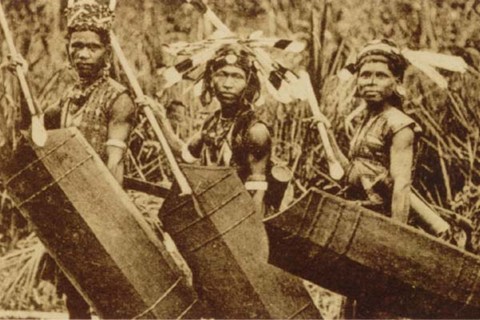
Headhunting of the literal sort figures quite prominently in Now the Hell Will Start, our 386-page labor o’ love. We dedicated an entire chapter to the practice, and thus field frequent questions from readers regarding whether or not the tribal inhabitants of North-East India and northwest Burma still take skulls. Our stock answer is that headhunting petered out after World War II, especially in areas that became heavily Christianized due to Western missionary activity. We did find one credible report of a raid that occurred in Burma in the mid-1990s, but nothing since.
But while organized headhunting may have died out in that part of the world, there seems to remain a cultural tradition that equates heads with dark magic. That, at least, strikes us as the most credible explanation for a beastly crime that just occurred in Assam. The perpetrators made off with the heads of six, including two young children. As noted in our book, the heads of kids were once highly prized as talismans, the logic being that such baubles are especially tough to obtain given the natural protectiveness of parents.
The Assamese case reminded us of one of the best works of reportage we’ve ever encountered: Richard Lloyd Parry’s “What Young Men Do”, which originally appear in Granta 62. It is an account of a headhunting epidemic that swept across Borneo in the late 1990s, when Dayaks committed terrible atrocities against Madurese immigrants. Parry essentially makes the argument that headunting is too woven into the fabric of Dayak life to ever vanish completely, especially since it was considered essential to manhood for untold centuries. This passage, in which Parry speaks with a Dutch missionary, has haunted us for years:
“Father, as a priest, how do you see all this?”
“It’s to difficult to say in two or three words, but to understand you have to go back sixteen years to when I arrived here. Compared to then, all the Dayaks are now Christians. They go to war with a cross. They’ve all bought rosaries. They are not killers.” And then, in English: “It’s very difficult to explain…
“Those involved in the war didn’t want any of it. They did it against their will. They didn’t intend to do anything wrong. They did it all unconsciously. Even if they killed four thousand people, they are not the killers of the Madurese.
“Dayaks have two sets of rules and teachings—the ones of their ancestors, and the rules and regulations set by the government. But when they are under pressure and need to express what they are all feeling in the face of that pressure, they have no choice. They have to go by the ancestral book.”
I asked where the Bible fitted into this.
“It’s difficult to say. Maybe those involved in the situation, deep in a trance based on the teachings of their ancestors, poorly educated…” He shook his head, and began another train of thought. “The educated ones didn’t get involved—they refused that kind of belief…”
I asked: “Is it a sin to cut the heads off Madurese?”
“I cannot see into people’s souls,” said the priest. “I can only see their actions and here I can see that they act together, not on their own, that they act because they believe it is a good thing. I say in church it is wrong to murder, you must save the life of every person living on earth and they understand that, but when it is war…there are other things.”
Parry convincingly argues that a headhunting epidemic will affect Borneo every generation, as young men itch to assert their bona fides. The Indonesian government would thus do well to start gearing up for 2015.


hubcap // Dec 31, 2009 at 10:22 am
I remember that piece. Along similar lines Paul Raffaele’s “Among the Cannibals” has a section set in New Guinea, and the way the Guineans talk about murder and cannibalism is similar – the victim is human but not really human; the killer is the person you know but also something different at the same time.
Jim // Jan 24, 2011 at 1:07 pm
Is this photo that accompanies your article on North East India one that is public domain?